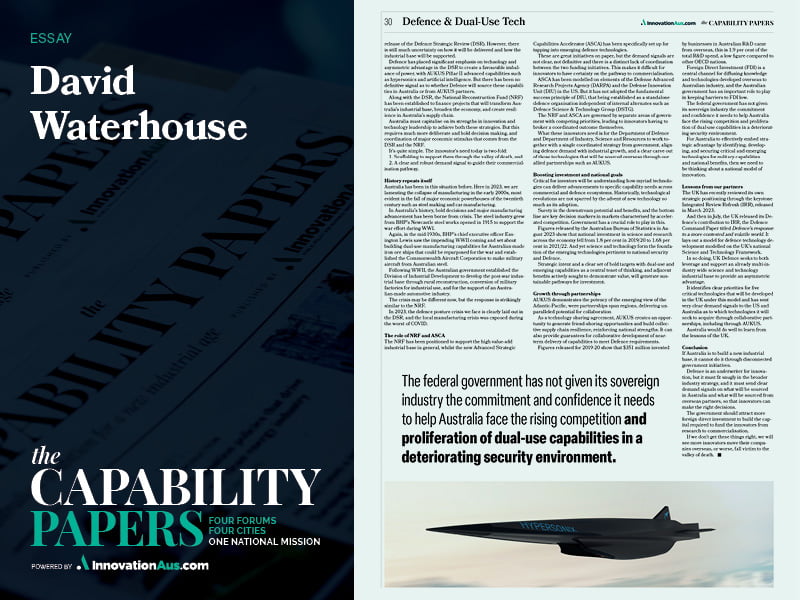The Valley of Death is real. As any Deep Tech or advanced manufacturing entrepreneur knows, there is a chasm between innovation and commercialisation that must be fully funded or risk a quick dagger through the heart and a gentle nudge into the abyss.
Australia holds significant potential to leverage its world-leading research and development in fields that stand to define a new epoch of emerging capabilities for defence and national security. The Australian Strategic Policy Institute (ASPI) ranks Australia in the top five in nine critical technology areas across artificial intelligence and advanced manufacturing.
However, considered with a broader aperture, Australia ranks significantly lower. Australia is placed 25th in the Global Innovation Index 2022, well behind prominent allies like the UK (4th) and the US (2nd).

Further, the Australian Government’s own five-year Productivity Inquiry published earlier this year identified that up to 98 per cent of Australian businesses do not produce “new-to-world innovations”, but rather they are “adopters, adapters, incremental improvers”.
For Australia, the imperative must be to develop a national model of innovation that generates widespread productivity gains, resulting in a resilient industrial base.
There are many mainstream technologies that we take for granted today that have been invented and developed by Australian innovators and entrepreneurs.
However, there are likely many more that didn’t make it to commercialisation because the chasm is so wide and the support from government to keep manufacturing here in Australia is weak. The defence industry is not immune to these challenges, with the cycle of spending having major impact on fledgling innovators caught out at the wrong time.
The defence industry in Australia has a fresh outlook and a degree of certainty on capability need following the release of the Defence Strategic Review (DSR). However, there is still much uncertainty on how it will be delivered and how the industrial base will be supported.
Defence has placed significant emphasis on technology and asymmetric advantage in the DSR to create a favourable imbalance of power, with AUKUS Pillar II advanced capabilities such as hypersonics and artificial intelligence. But there has been no definitive signal as to whether Defence will source these capabilities in Australia or from AUKUS partners.
Along with the DSR, the National Reconstruction Fund (NRF) has been established to finance projects that will transform Australia’s industrial base, broaden the economy, and create resilience in Australia’s supply chain.
Australia must capitalise on its strengths in innovation and technology leadership to achieve both these strategies. But this requires much more deliberate and bold decision making, and coordination of major economic stimulus that comes from the DSR and the NRF.
It’s quite simple. The innovator’s need today is two-fold:
1. Scaffolding to support them through the valley of death, and
2. A clear and robust demand signal to guide their commercialisation pathway.
History repeats itself
Australia has been in this situation before. Here in 2023, we are lamenting the collapse of manufacturing in the early 2000s, most evident in the fall of major economic powerhouses of the twentieth century such as steel making and car manufacturing.
In Australia’s history, bold decisions and major manufacturing advancement has been borne from crisis. The steel industry grew from BHP’s Newcastle steel works opened in 1915 to support the war effort during WWI.
Again, in the mid-1930s, BHP’s chief executive officer Essington Lewis saw the impending WWII coming and set about building dual-use manufacturing capabilities for Australian-made iron ore ships that could be repurposed for the war and established the Commonwealth Aircraft Corporation to make military aircraft from Australian steel.
Following WWII, the Australian government established the Division of Industrial Development to develop the post-war industrial base through rural reconstruction, conversion of military factories for industrial use, and for the support of an Australian-made automotive industry.
The crisis may be different now, but the response is strikingly similar to the NRF.
In 2023, the defence posture crisis we face is clearly laid out in the DSR, and the local manufacturing crisis was exposed during the worst of COVID.
The role of NRF and ASCA
The NRF has been positioned to support the high value-add industrial base in general, whilst the new Advanced Strategic Capabilities Accelerator (ASCA) has been specifically set up for tapping into emerging defence technologies.
These are great initiatives on paper, but the demand signals are not clear, not definitive and there is a distinct lack of coordination between the two funding initiatives. This makes it difficult for innovators to have certainty on the pathway to commercialisation.
ASCA has been modelled on elements of the Defense Advanced Research Projects Agency (DARPA) and the Defense Innovation Unit (DIU) in the US. But it has not adopted the fundamental success principle of DIU, that being established as a standalone defence organisation independent of internal alternates such as Defence Science & Technology Group (DSTG).
The NRF and ASCA are governed by separate areas of government with competing priorities, leading to innovators having to broker a coordinated outcome themselves.
What these innovators need is for the Department of Defence and Department of Industry, Science and Resources to work together with a single coordinated strategy from government, aligning defence demand with industrial growth, and a clear carve out of those technologies that will be sourced overseas through our allied partnerships such as AUKUS.
Boosting investment and national goals
Critical for investors will be understanding how myriad technologies can deliver advancements to specific capability needs across commercial and defence ecosystems. Historically, technological revolutions are not spurred by the advent of new technology so much as its adoption.
Surety in the downstream potential and benefits, and the bottom line are key decision markers in markets characterised by accelerated competition. Government has a crucial role to play in this.
Figures released by the Australian Bureau of Statistics in August 2023 show that national investment in science and research across the economy fell from 1.8 per cent in 2019/20 to 1.68 per cent in 2021/22. And yet science and technology form the foundation of the emerging technologies pertinent to national security and Defence.
Strategic intent and a clear set of bold targets with dual-use and emerging capabilities as a central tenet of thinking, and adjacent benefits actively sought to demonstrate value, will generate sustainable pathways for investment.
Growth through partnerships
AUKUS demonstrates the potency of the emerging view of the Atlantic-Pacific, were partnerships span regions, delivering unparalleled potential for collaboration
As a technology sharing agreement, AUKUS creates an opportunity to generate friend-shoring opportunities and build collective supply chain resilience, reinforcing national strengths. It can also provide guarantees for collaborative development of near-term delivery of capabilities to meet Defence requirements.
Figures released for 2019-20 show that $351 million invested by businesses in Australian R&D came from overseas, this is 1.9 per cent of the total R&D spend, a low figure compared to other OECD nations.
Foreign Direct Investment (FDI) is a central channel for diffusing knowledge and technologies developed overseas to Australian industry, and the Australian government has an important role to play in keeping barriers to FDI low.
The federal government has not given its sovereign industry the commitment and confidence it needs to help Australia face the rising competition and proliferation of dual-use capabilities in a deteriorating security environment.
For Australia to effectively embed strategic advantage by identifying, developing, and securing critical and emerging technologies for military capabilities and national benefits, then we need to be thinking about a national model of innovation.
Lessons from our partners
The UK has recently reviewed its own strategic positioning through the keystone Integrated Review Refresh (IRR), released in March 2023.
And then in July, the UK released its Defence’s contribution to IRR, the Defence Command Paper titled Defence’s response to a more contested and volatile world. It lays out a model for defence technology development modelled on the UK’s national Science and Technology Framework.
In so doing, UK Defence seeks to both leverage and support an already multi-industry wide science and technology industrial base to provide an asymmetric advantage.
It identifies clear priorities for five critical technologies that will be developed in the UK under this model and has sent very clear demand signals to the US and Australia as to which technologies it will seek to acquire through collaborative partnerships, including through AUKUS.
Australia would do well to learn from the lessons of the UK.
Conclusion
If Australia is to build a new industrial base, it cannot do it through disconnected government initiatives.
Defence is an underwriter for innovation, but it must fit snugly in the broader industry strategy, and it must send clear demand signals on what will be sourced in Australia and what will be sourced from overseas partners, so that innovators can make the right decisions.
The government should attract more foreign direct investment to build the capital required to fund the innovators from research to commercialisation.
If we don’t get these things right, we will see more innovators move their companies overseas, or worse, fall victim to the valley of death.
David Waterhouse has more than 30 years’ experience working in the Space and TMT (Technology, Media, Telecom) sector. He is co-founder of Hypersonix Launch Systems, an Australian engineering, design and build company specialising in hypersonic vehicles and scramjet engines to provide sustainable, affordable access to space. Mr Waterhouse has been a senior c-suite executive for more than 20 years, including roles with PCCW, Cable and Wireless, Telikom and Telstra businesses in Australia, Asia, the Pacific, Europe and the Middle East. David is a satellite engineer and a fellow of Engineers Australia. His degrees include an MBA, a Masters in Research and Honours Engineering degrees. He’s passionate about commercialising innovative technology that solves some of the world’s biggest problems.
Do you know more? Contact James Riley via Email.

